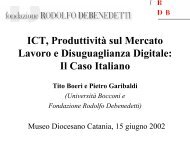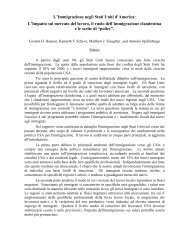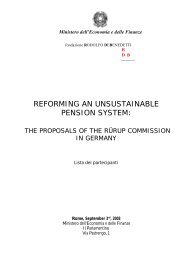The Executive Compensation Controversy - Fondazione Rodolfo ...
The Executive Compensation Controversy - Fondazione Rodolfo ...
The Executive Compensation Controversy - Fondazione Rodolfo ...
Create successful ePaper yourself
Turn your PDF publications into a flip-book with our unique Google optimized e-Paper software.
THE EXECUTIVE COMPENSATION CONTROVERSY: 24 MAY 2010A TRANSATLANTIC ANALYSIS<strong>The</strong> backlash over CEO pay associated with the accounting and backdating scandalstriggered additional rounds of pay-related legislation and regulation. Enacted in 2002, theSarbanes-Oxley bill banned company loans to top executives and also required CEOs andCFOs to return ill-gotten bonuses and option gains following accounting restatements. 20 In2004, as a direct response to Enron (where a small number of executives were allowed towithdraw millions of dollars from their deferred compensation accounts just prior to thecompany’s bankruptcy), Congress added Section 409(A) to the Internal Revenue Code tolimit the flexibility in the timing of elections to defer compensation. In 2006, the FinancialAccounting Standards Board (FASB) began requiring firms to take an accounting charge forgranting options, and the SEC adopted significant new disclosure rules for executivecompensation affecting how (and what) compensation is disclosed and how companies mustdescribe their compensation policies and practices.<strong>The</strong> CEO pay controversies in 1933, 1982, 1992, 2006 and 2009 – and resulting callsfor government action – share several common themes. First, all occurred in economicrecessions or downturns that followed years of relative prosperity associated with largeincreases in executive compensation (and increases in USA income inequality moregenerally). Second, the controversies led to government action that was almost uniformlyeither ineffective or counterproductive, typically increasing (rather than reducing) CEO payand leading to inefficiencies in pay practices. Finally, while the controversies have touchedon legitimate issues concerning executive compensation, the most vocal critics of CEO pay(such as members of labor unions, disgruntled workers and politicians) have been uninvitedguests to the table who have had no real stake in the companies being managed and no realinterest in creating wealth for company shareholders.In this Section, we will explore the evolution of CEO pay in the USA: if pay structuresin the USA are indeed being imported into Europe, it is important to understand theirgenealogies. We begin with a challenging (and not completely satisfactory) discussion ofhow to measure CEO pay, a necessary component of any time-series. cross-sectional, orcross-country analysis. We then discuss the rise and fall of stock options in the USA, untilrecently the most important and distinctive component of executive compensation. Finally,we discuss the distinction between the “cost” of an executive compensation package from thestandpoint of the employer (i.e., the shareholders), and the value of that same package fromthe standpoint of the risk-averse and undiversified executive. This distinction is critical in20 <strong>The</strong> Sarbanes-Oxley Act also essentially halted option backdating by requiring that option grants bereported within two days following the grant. This desirable outcome was an unintended (albeit positive)consequence of the Act, since the backdating scandal was not unearthed until after the Act was enacted.-8-









